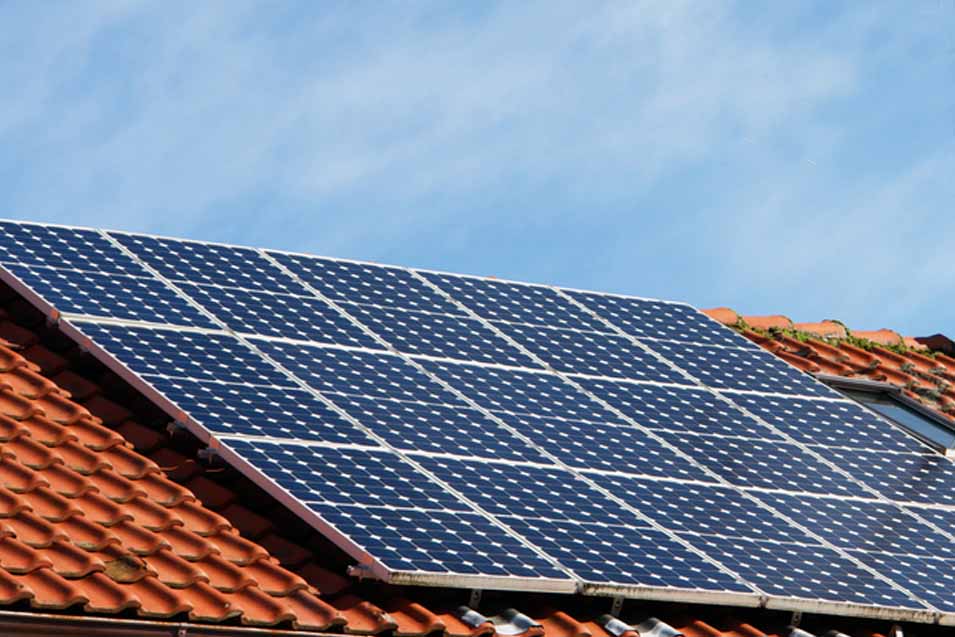
Solar energy is a growing business. Demand increased by 27% in the U.S. in 2004. It’s no wonder—the sun sends the Earth more power in an hour than the entire planet uses in a year. We still have a long way to go in harnessing that power, however; solar power still accounts for only about .01% of the total global energy output. But it’s expected to continue to grow—solar technology is constantly improving. If you’re looking into solar energy for your home, here are answers to some of the most common questions about solar energy.
How does solar power work?
A solar panel is made of a group of “cells,” or units made of a semiconductive material that takes in light easily and efficiently. The material used is often crystalline silicon, and it’s arranged in several vertical layers in the panel—topped with a clear, protective layer and backed by a layer of polymer. The top layer is electrically negative, and the bottom is electrically positive. When sunlight hits the cell, it knocks loose electrons in the silicon layers. Because of the difference in charge, the electrons move from the top to the bottom of the cell, passing through a circuit on the way that transforms their energy into electricity.
How much does it cost to install solar panels in my home?
A rooftop solar array can cost anything from $10,000 to $20,000 or more to install. However, there are state and federal programs that encourage solar power by giving rebates and tax incentives to homeowners who install solar panels. Fifteen states in the U.S. have public benefit funds for the purpose of subsidizing solar energy, and 24 give rebates for home solar power installation. In New Jersey and New York, for example, the state will refund up to 70% of the cost of installing solar panels.
If I use solar energy, do I have to cut down on my energy usage?
Not necessarily. Solar cells are more efficient than they’ve ever been, and many people find they can use all the electrical appliances they’re used to after installing solar panels. Many homeowners with solar panels on their roofs are also hooked into the electrical grid, so they get energy from a combination of sources. While they’re still dependent on fossil fuels, it’s to a lesser extent—and the traditional utilities make sure they don’t notice a difference in how much energy they can use. If you install solar panels, you’ll still be able to use all the appliances you’re accustomed to using.
Will a solar array look bad on my home?
It shouldn’t. Today’s solar panels are more unobtrusive than ever. They typically show up a bit darker than the surrounding shingling, making it look like your roof is being patched—but it won’t make your house stick out like a sore thumb, either.
Does my location affect how much energy I get from solar panels?
Yes, it does. Solar panels will work anywhere in the world. However, as you’d expect, they work best in areas that get the most sunlight. Some areas of the globe get more sunlight hours than others, and a solar panel in Canada, for example, has to work harder to produce the same amount of electricity as one in New Mexico.
How much savings can I expect from solar panels?
It depends on your energy usage, as well as whether you’re still hooked up to the grid after your solar panels are installed. It’s possible for your energy savings in solar power to pay back your installation investment, but in all cases it can take many years—even decades. Most people who install solar panels do it for environmental reasons, not to save money.
I’ve heard that people with solar panels actually see their meters run backwards. Is that true?
Yes. It’s actually possible to produce more energy than you use—and you can sell the energy back to the utility company if you’re hooked up to the grid.
I’m building a home in a rural area. I’ve heard it’s actually cheaper to install solar panels than to have the electric company extend a power line. Is this true?
It can be—it depends on how far you are from an existing power line. Utility companies can charge anywhere from $20,000 to $80,000 per mile to extend a line. Given this, solar panel installation might be the most cost-effective choice for your new home.
Many people install solar panels because they feel they’ll be more prepared for a future energy crash—and there may be something to that belief. Scientists estimate that our known reserves will last us only from 40 to 70 years at current rates of usage—and those rates are only increasing. Regardless of the future, solar panels are an excellent way to save energy now—and do something positive for the environment.

